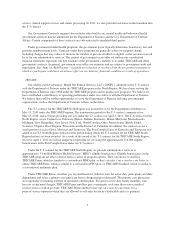Health Net 2011 Annual Report Download - page 21
Download and view the complete annual report
Please find page 21 of the 2011 Health Net annual report below. You can navigate through the pages in the report by either clicking on the pages listed below, or by using the keyword search tool below to find specific information within the annual report.and initiated lawsuits challenging its constitutionality. These challenges are pending final adjudication in several
jurisdictions, including the U.S. Supreme Court. Congress has also proposed a number of legislative initiatives,
including possible repeal of the ACA. In 2011, the President signed legislation to eliminate $2.2 billion of the $6
billion in start-up funding that the ACA provided to support the launch of health insurance cooperatives, and
Congress may also withhold the funding necessary to implement the ACA. At this time, it remains unclear whether
there will be any changes made to the ACA, whether to certain provisions or its entirety. If the individual mandate is
struck down, but provisions relating to “guaranteed issue” are upheld, people with greater needs for health care
services could make up a greater portion of our membership, which would have an adverse impact on our medical
loss ratios, profitability and earnings. These effects could be exacerbated if we are unable to obtain, or are delayed
in obtaining, regulatory approval of adequate premium rates for the risk we assume.
Due to the unsettled nature of these reforms and the numerous steps required to implement them, we cannot
predict how future regulations and laws, including state laws, implementing the health care reform legislation
will impact our business. To date, the legislation has not had a material adverse impact on our business, financial
results and results of operations. However, in the future, depending in part on the ultimate requirements of the
legislation, it could have a material adverse effect on our business, financial condition and results of operations.
Medicare Legislation and Regulation. Comprehensive legislation, specifically Title XVIII of the Social
Security Act of 1935, as amended (most recently by the ACA), governs our Medicare program. In addition, our
Medicare contracts are subject to regulation by CMS. CMS has the right to audit Medicare contractors and the
health care providers and administrative contractors who provide certain services on their behalf to determine the
quality of care being rendered and the degree of compliance with CMS’ contracts and regulations.
See “—Medicare Products” for more information on our Medicare business and see “Item 1A. Risk
Factors—Federal and state audits, reviews and investigations of us and our subsidiaries could have a material
adverse effect on our operations,financial condition and cash flows” for a description of the risks associated
with our Medicare business, including recent CMS sanctions against us and the ongoing suspension of our auto-
enrollment and reassignment of LIS beneficiaries.
Medicaid and Related Legislation. Federal law has also implemented other health programs that are
partially funded by the federal government, such as the Medicaid program (known as Medi-Cal in California) and
CHIP (known as the Healthy Families program in California). Our Medi-Cal program is regulated and
administered by the DHCS and the Healthy Families program is regulated by the Managed Risk Medical
Insurance Board. Federal funding remains critical to the viability of these programs, particularly in light of
California’s state budget deficits. Federal law permits the federal government to oversee and, in some cases, to
enact, regulations and other requirements that must be followed by California with respect to these programs.
Medicaid and CHIP are administered at the federal level by CMS.
On October 27, 2011, CMS approved certain elements of California’s 2011-2012 budget proposals to reduce
Medi-Cal provider reimbursement rates as authorized by California Assembly Bill 97 (“AB 97”). The elements
approved by CMS include a 10 percent reduction in a number of provider reimbursement rates. The DHCS has
preliminarily indicated that the Medi-Cal managed care rate reductions could be effective retroactive to July 1,
2011. Recently, the United States District Court for the Central District of California issued a series of
injunctions barring the California Department of Health Care Services from implementing the rate reductions as
to various classes of providers. If AB 97 is ultimately implemented as proposed, we believe that the approved
reductions in provider payments would result in a premium reduction from the Medi-Cal business conducted in
our California health plan. In addition, our ability to obtain health care cost recoveries from providers relating to
any implemented rate cuts could affect the financial results of our California health plan. However, due to the
preliminary injunction in effect and other uncertainty regarding the final implementation of AB 97, we cannot
reasonably estimate the range of reductions in premiums and/or related health care cost recoveries that may result
in connection with AB 97.
19
























